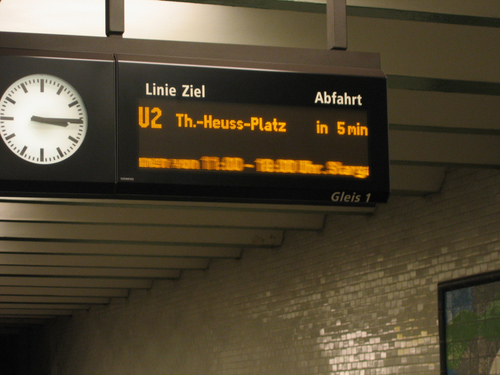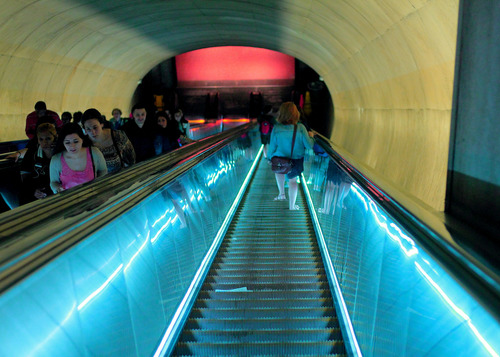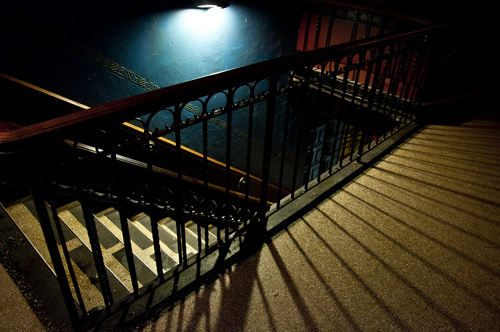Why can’t Metro change how it runs escalators, what info its signs display, or how easy it is to walk on station stairs?
There will soon be compass roses outside of every Metro station to help riders find their way thanks to our MetroGreater contest. This was a great idea, but so were others, like making the system’s escalators and signs more sensible and making dimly-lit stairs easier to walk on. Here’s why those ideas didn’t win.

This sign in Berlin isn’t that different from Metro’s, but the white paint at the top actually makes a big difference in how much info the sign can display. Photo by Matt Johnson.
No need to change how the escalators run… right?
One idea, from Larry M., was to “run escalators with rationale,” or in other words, run them in the direction most people want to go in. For example, if it’s rush hour at a more suburban station, it’d probably make sense to set most of the escalators to run out of the station, as the majority of the users are probably on their way out. During particularly busy events, the escalators can sometimes become the limiting factor preventing people from entering or leaving a station — not the trains — so making sure they’re configured properly can be a big deal.
According to a Metro representative I spoke with, this is already happening all over the system. Metro’s overall approach is to run more escalators out of stations rather than in since people tend to trickle in to wait on trains but leave all at the same time. In other words, Metro says its approach to escalators is rational.
Station managers also generally don’t reverse escalators by themselves; the reversal process typically requires two people for safety— one at the bottom and one at the top— to make sure nobody tries to get on while it’s being reversed. Also since escalators can wear into operating in a particular direction, it might require a “tune-up” of sorts before being switched in the opposite direction.
One way to ensure that escalators do in fact run in a rational direction would be to encourage— or even require?— station managers that might not already be doing so to walk around the inside of the station every so often to make sure not only the escalators and other equipment are working properly, but also to ensure the escalators are set in the direction of the most traffic when possible.
At stations with more than two escalators at an entrance, ensure at least one is going in either direction, and allow the third or fourth to be switched per the station manager’s discretion (with the help of escalator maintenance or MTPD). Or maybe an internal Metro department should perform more unannounced “spot” checks to ensure the escalators are in the right positions. Or maybe there should be better schedules for station managers to use to know which directions their escalators should be running in to best manage crowds.
Changing Metro’s display screens would take too long
Another suggestion, this one from from Scott K. in Alexandria, was to create extra space on Metro PID displays by painting the Line/Car/Destination headings, which currently take up a row on the screen itself, onto the actual signs.
As Matt Johnson wrote back in 2010, that’d mean room for both estimated train arrival times, as well as other crucial info, all on the same screen:
With this approach, Metro’s signs could use the top three rows for next trains and the bottom row for disruptions and elevator outages. Major disruptions might warrant using the bottom 2 rows. If there are no disruptions, four next train departures could be shown.
According to the Metro official I spoke with, this idea isn’t doable because it’d take longer than six months, and part of the MetroGreater rules were that ideas have to be doable within less time than that. More specifically, painting all of the PIDS would require track access at each station, which would mean shutting down power and working the updates in with other overnight system work already on the schedule. It’d also mean experimenting with the best paint materials, which would take a while.
Stairwells could be easier to see in
Another idea came from Melanie in Arlington, who suggested adding reflective stripes to stairs in dimly-lit stairwells, like on the eastern side of the Navy Yard station, so people walking on them are less likely to fall.
When I spoke to Metro, they said this is an idea the agency is open to, and may try out as a pilot at a few stations to figure out what materials, colors, and reflective surfaces, work best and are least confusing to passengers. There was a concern that installing and maintaining striping could cost more than $100,000 over the long run given time and material costs.
Metro is definitely aware that lighting around its stations isn’t totally adequate. One line of the WMATA Customer Accountability Report includes some station lighting improvements, partly due in thanks to the Accessibility Advisory Committee. The agency is currently testing a few different types of station lighting for the entire system, although there’s no timeline for that project yet.
While these three ideas didn’t make the cut in MetroGreater, there’s no reason to stop talking about them. Metro General Manager Paul Wiedefeld is continuing to beat the drum of safety, reliability, financial well-being, and a focus on the customer. Small improvements proposed by customers are likely to be a key way for the system to get better.
Update: We’ve updated this post to include more detail on Metro escalator policy which says most escalators should be in the up direction out of a station. The post previously did not make note of this policy, which can restrict which station managers are allowed to change escalator directions.


